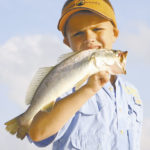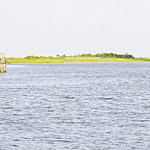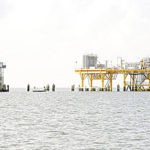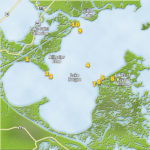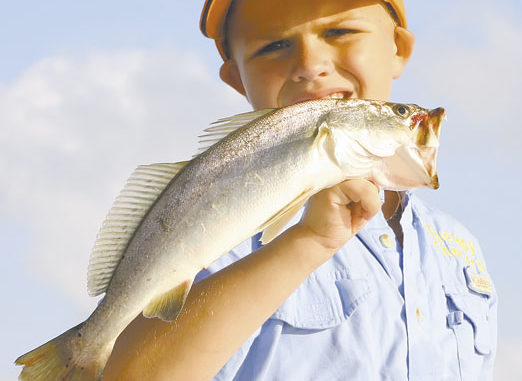
This underfished water body has been loaded with speckled trout this summer.
To say that Lake Borgne and Rodney Dangerfield have a lot in common might be a little too strong. At least everybody knew who Rodney Dangerfield was even if they didn’t respect him.
Aaron Brooks is a better comparison. The former New Orleans Saints quarterback didn’t get a lot of respect either, but he was hardly known outside the Louisiana Superdome.
Whether he was smiling after throwing an interception, leaving the field early or throwing a backward pass, Brooks was a walking contradiction. He had all the talent in the world, but he had a hard time trying to figure out what to do with it.
In the same way, Lake Borgne has all the fish in the world, but hardly anybody knows what to do with it. More often seen as a vast obstacle to navigate on the way to the Biloxi Marsh, Lake Borgne just “don’t get no respect.”
However, Brooks could put it all together every now and then to have the kind of performance that Saints fans are now used to seeing Sunday after Sunday. In other words, Brooks wasn’t good all the time, but when he was on, he made us think he was a real NFL quarterback.
Lake Borgne is on. And a few anglers have put it all together to have the kind of fishing trips that would make one think they were fishing “real” saltwater fisheries like Breton Sound, Venice or Calcasieu Lake.
Capt. John Falterman Jr. is one of the few who have figured out how to give Lake Borgne its props. The first thing one notices when Falterman posts pictures of his catches at www.LouisianaSportsman.com is the floor of his 24-foot Triton bay boat is covered with fish.
125, 87, 75, 90 — it’s a good thing his fish-counter clicker has three digits on it. Falterman routinely breaks the triple-digit barrier or gets mighty close to it during the summer. A model of consistency, Falterman owes most of his success to where he fishes rather than what he fishes.
“You can come to Lake Borgne with all kinds of soft plastics, topwaters, spinner blades — whatever,” he said. “But you better not leave the marina without a baitwell full of live shrimp this time of year. If you get on them good, you can switch to soft plastics, but in the meantime, stick with shrimp.”
• No. 1: Chef Pass Cut
N30 03.107 x W89 46.680
Right before Chef Pass enters Lake Borgne, there is a canal that intersects it to the north and south. This cut is basically just a little marsh line with some shallow grass, which makes it good for redfish. But there is also a little drop about 30 yards off the bank that makes it good for trout.
“The water is really protected in here,” Falterman said. “That makes it good for spotting redfish cruising down the grass lines. If you have a small boat, this is the spot for you if you don’t want to go out in Borgne. Cast shrimp or cocahoes under a cork.”
Falterman hits the reds by positioning his boat about 20 to 30 yards away from the bank and casting toward the shoreline. However, if he’s after speckled trout, he backs off a little, and fishes the drop and deeper water out toward the middle of the cut.
“You can stay with the shrimp under the cork on the trout if you want to,” Falterman added, “but you could also try fishing shrimp on a Carolina rig to keep them closer to the bottom. I’ve also caught some good trout in here fishing shrimp on a 1/8- or 1/4-ounce jighead just freelining them on the drop.”
• No. 2: Alligator Point Rig
N30 00.829 x W89 43.097
Easily one of the most frequently fished rigs in Lake Borgne, the Alligator Point rig is hard to miss as you exit Chef Pass into the lake. It actually consists of a bigger yellow rig with a smaller concrete rig to the side. And the bigger yellow rig has a yellow flare arm that hangs off the side.
“I stay away from the flare arm because you never know when that thing might go off,” Falterman said. “You can fish a number of different ways — tying off to the pilings, anchoring between the two rigs, trolling. I like to jump around until I find a good group of trout, and then I’ll anchor down.”
Falterman jumps around because this rig frequently holds a lot of white trout. And he’s often fished through big pods of whites before finally finding the specks. It’s just a matter of moving around to find them.
“However you fish, make sure to fish 360 degrees around your boat,” Falterman advised. “Fish could literally be anywhere around this rig, so stick with Carolina-rigged live shrimp, and drag it around until you find the right spot. It’s nothing like the bridges in Pontchartrain, but it holds some decent trout.”
• No. 3: Alligator Point Well Head
N30 00.350 x W 89 42.724
Although this little well head to the east of the Alligator Point rig is a lot smaller, it sometimes holds larger trout. It’s not big enough for very many boats, but Falterman has seen three or four boats around it all successfully catching fish.
“I like to start out about 100 yards away from this well head and fish toward it with a Carolina-rigged live shrimp,” he said. “The water is about 10 feet around it, and there’s a good shell pad on bottom that surrounds it. Like all these other rigs, the shell pad is what attracts fish to this spot.”
Although he prefers the sliding cork on some of the bigger rigs, Falterman says this particular well head is a good one for sliding corks. He sets his about 9 feet deep so that his shrimp is hanging about a foot off the bottom.
“You’ll see a lot of boats tying off to the structure itself, and that’s a good way to fish it as long as nobody’s on it when you arrive,” Falterman said “If you’re able to do that, try fishing a live shrimp on a drop-shot rig so your weight is on bottom with your shrimp about a foot or two above it.”
• No. 4: Tulane Rig
N30 01.600 x W89 36.323
Best known for the green-and-white tanks near the barge section of this rig, the Tulane rig is actually two main platforms surrounded by pilings and a well head. Falterman says this is the place to go if you’re looking to put some fish in the box without worrying about them being all speckled trout.
“Set some sliding corks about 10 feet deep, and fish all around the structure until you find them,” Falterman advised. “They will tend to group up in certain spots, but those spots could change. They may all be within the pilings one day and 200 yards off to the side the next.”
Although Falterman regularly fishes live shrimp during the summer, he explained that the Tulane rig is one of the few places where he can get a plastic bite. He doesn’t start out with them, but he will switch to a motor oil or purple Marsh Works Bayou Thumper, both with chartreuse tails.
“Those and the Gulps can work out here,” he said. “Just bump them on the bottom all the way back to your boat. The one thing about this rig in August, though, is that it’s an extremely early bite. I like to get to it about 45 minutes before daylight, and fish until 7:00.”
• No. 5: Point aux Marchettes
N29 59.806 x W89 33.720
This spot is basically the eastern shoreline of Lake Borgne close to Point aux Marchettes. Anywhere from the cut leading into Bayou Biloxi going back to Bayou Magill and on to Point aux Marchettes can get thick with redfish. And the fishing is good here on into October.
“If you can get the right winds — either east or light west — you can get up in here and throw to cruising reds all day long,” Falterman said. “They get right on the bank, so fish tight, especially on an incoming tide. This is also the spot to catch reds if you have too big of a boat to get back in the marsh.”
Falterman recommended throwing shrimp under a popping cork, but he says they will also eat spinnerbaits. He’s been throwing the Marsh Works blade with a purple plastic with a chartreuse tail. Gold spoons also work well along this shoreline.
“Most of it is sight casting to pushing reds,” Falterman said, “but if the water is murky or the sun isn’t right, you’re going to have to blind cast. In that case, just fish points and pockets, and you’ll do fine.”
• No. 6: Lake Shore Cut 1
N29 59.543 x W89 34.202
Turn right into Lake Shore Bayou off of Bayou Biloxi where it enters the Biloxi Marsh, and look for the first cut that turns back east and connects Lake Shore Bayou with Lake Borgne. While it might not look like much, Falterman says it holds lots of redfish and some flounder.
“It’s kind of shallow, but if you can get your boat in there from the Lake Borgne side, you can troll through and throw to waking reds as they move back into Lake Shore Bayou in front of you as you move through,” Falterman said. “It’s kind of like you use your boat to push them out the other side of the cut.”
Once he exits the cut in Lake Shore Bayou, Falterman notices that the reds will scatter in both directions at the mouth of the cut. They won’t go far, though, and anglers can typically sit in front of the cut and continue to catch reds as they roam around before heading back into the cut.
“Use popping corks with live bait,” Falterman suggested. “Spinnerbaits and gold spoons are also good. The cut is only about 20 feet wide, so you’re going to move fish as you troll through. Throw in front of them to their noses when you see them moving.”
• No. 7: Lake Shore Cut 2
N29 59.533 x W89 34.592
The second cut that connects Lake Borgne to Lake Shore Bayou behind Point aux Marchettes is bigger than the first cut, but it fishes almost the same way. It may be longer and wider than the first cut, but it’s somewhat shallower at only about 1 1/2 feet.
“If you can make it to this spot, it doesn’t matter what the weather is doing or how big the swells are in Lake Borgne,” Falterman said. “This is a great spot to get away from the wind even if there are 4-foot swells out in the lake. It has smooth water all the time.”
Falterman likes to fish through the cut from the Borgne side to push the reds out into the big bend in Lake Shore Bayou. Like the first cut, he casts shrimp, spinnerbaits and spoons in front of the pushing fish. However, when fishing shrimp under a cork, he goes only about 15 inches deep.
“This is just a nice area to stop and fish because you can catch a lot of redfish,” Falterman went on. “When you get them back out in the bend in Lake Shore Bayou, you can sit there and catch limits of reds for everybody in your boat.”
• No. 8: Bayou Magill Pond
N29 59.971 x W89 31.574
The most interesting thing about this spot other than the fact that it holds huge numbers of redfish and speckled trout is that hardly anybody ever fishes it. Falterman doesn’t know if it’s just unknown or if people just don’t want the inconvenience of running to it, but he’s rarely seen other boats in this pond.
“It opens up a lot back here, and there is a lot of current movement,” said Falterman. “It stays about 3 or 4 feet, but there are also some good channels that you can spot by the crab traps. And as long as you can get back here, you’re going to find calm water.”
Falterman checks the redfish around points that have current moving around them with live shrimp or cocahoes under popping corks and with spinnerbaits. He also looks for moving reds, to which he sight casts.
“As for the trout,” Falterman said, “they get out around the deeper drops on the edges of the channels. I fish the trout back here until September by throwing live shrimp or the Gulp stuff under a cork set about 2 1/2 to 3 feet deep.”
• No. 9: Bridge Rig
N30 07.831 x W89 37.302
This large structure sits just to the east of the old L&N Bridge that is now known as the CSX Bridge. It’s one of the first rigs anglers will spot to the right as they exit the Rigolets under the bridge. Because it’s so close to the Rigolets and the Intracoastal Waterway, there’s always some water moving around it.
“Play the current set up based on whether you want to throw with the current or into it,” Falterman said. “There are a lot of trout, redfish and drum around it, and it’s a good spot to fish if you don’t want to go way out into Borgne.”
Falterman sticks with live shrimp on this rig, and he typically tries Carolina rigs, drop shots and sliding corks. The water is about 8 to 9 feet around this spot, and with all the current, he plays around with depths and weights to keep his bait near the bottom.
“There are three rigs around here, but this one produces the best,” Falterman said. “And if the reds are here, you can expect to catch a lot of oversized fish. The drum can get pretty big here, too. Trout here aren’t as big as what you’ll get at the Tulane rig, but they’re usually decent fish.”
• No. 10: Rabbit Island
N30 08.476 x W89 37.996
Falterman says this island is one of those kinds of spots where anglers can go and sit all day long and catch a lot of fish without a lot of worries. The water behind the island goes into the back side of the Intracoastal Waterway and comes out by the CSX Bridge.
“You’re always going to have water movement here no matter what,” Falterman said. “With the water going into and leaving Lake Pontchartrain, all the water going through the Intracoastal, and the Lake Borgne water, you’ve got a spot where all this water movement mixes together.”
Small shell piles and sand beaches surround this island, too. Put those together with the water movement, and it’s no wonder so many trout and redfish stack up around this island. In sticking with the spot’s simplicity, Falterman doesn’t do anything fancy here.
“Live shrimp under a drop shot or Carolina rig,” he said. “I work all the way around the island fishing the points and pockets that surround it. You could also work shrimp under a sliding cork or a popping cork. The key here is to just keep it simple and fish.”
Contact Capt. John Falterman at 504-915-0693.
